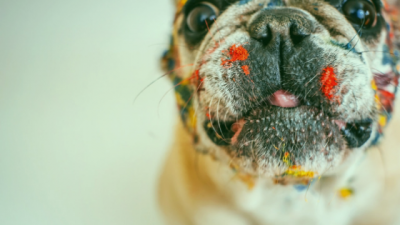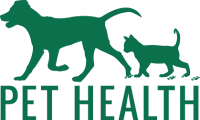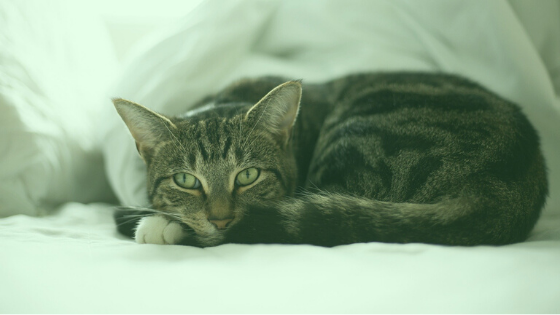School Supply Hazards
 Can school supplies be hazardous to pets? It might seem natural to assume that supplies for children would be safe for both humans and their animal companions. If mistaken for toys or food, however, commonplace items found in backpacks like erasers, glues, or pencils can pose a safety hazard to dogs and cats.
Can school supplies be hazardous to pets? It might seem natural to assume that supplies for children would be safe for both humans and their animal companions. If mistaken for toys or food, however, commonplace items found in backpacks like erasers, glues, or pencils can pose a safety hazard to dogs and cats.
Toxic Substances
Because they’re intended for children’s use, most school supplies do not include toxic materials. However, animals may be sensitive to different substances than humans, so harmless things for humans may prove dangerous for their pets. When in doubt regarding the toxicity of any material, call the Pet Poison Helpline or your veterinarian.
Art Supplies
In her article Toxicity of Art Supplies, Dr. Charlotte Means explains how the risk of toxicity often varies according to what sort of art medium or material the pet was exposed to. She outlines the sort of questions a veterinarian might need to have answered in order to help assess the threat to the pet’s health:
- What media or medium is involved?
- How was the pet exposed?
- What other substances were present?
- What were the brands and colors of the media?
- Is an Art and Creative Materials Institute (ACMI) seal present on the medium?
Look for the ACMI certification when purchasing art supplies. The Approved Product (AP) Seal certifies that a product does not have sufficient quantities of any material that could be toxic to children, and is the more commonly seen label (particularly among school supplies). The Cautionary Labeling (CL) Seal is used on products that do contain toxic material that could be harmful if not used according to directions or without taking proper precautions.
Most art supplies—specifically those made for children—carry the AP Seal. In general, chalks, pen inks, and erasers are considered non-toxic. Modern “lead” pencils are actually made of graphite, and so pose more of a choking hazard than a toxicity risk. Most types of glue are also non-toxic, though Dr. Means explains that they can cause other sorts of problems if the glue gets on a pet’s eyes or mouth:
If the mouth or eyelids are glued shut, soften the area with tepid water; gauze soaked with mineral oil or ophthalmic ointment can also be used on eyelids. Eyelids generally separate in 1-4 days. Rarely, corneal ulceration may occur. […] Hardened glue in the skin or the mouth will wear off within a few days, and it is best to leave the glue in place. Glue that is attached to the fur can be clipped off.
While the majority of art supplies pose little to no risk of toxicity, certain paints, solvents, clays, and glazes may be harmful through inhalation, ingestion, or physical contact. A pet exposed to only small amounts of these substances may be asymptomatic or only display minor symptoms such as digestive upset, but exposure to large amounts of these substances may result in severe conditions including respiratory problems, heart conditions, or renal failure. Common treatments for high levels of toxicity include enemas, chelation, and bulking the diet, but no treatment should be administered without the supervision or advice of a professional veterinarian.
Toxic Plastics and Lead
Polyvinyl chloride (PVC) is a general purpose plastic containing dangerous chemicals such as phthalates and lead. Although a 2008 law banned phthalates from being used in children’s toys and “child care items,” this didn’t extend to the manufacture of children’s school supplies. A disturbing number of school supplies are still manufactured with PVC, including backpacks, binders and organizers, and even lunchboxes.
Salt Dough Dangers
The American Society for the Prevention of Cruelty to Animals (ASPCA) notes the dangers of a specific common holiday project for school-aged children: salt dough. Comprised of flour, water, and salt, this substance may seem harmless enough, but if eaten the high levels of salt may cause vomiting, drinking lots of water, and increased sodium levels in the blood. Even small amounts of salt dough can be harmful because high levels of sodium can lead to seizures and even death if left untreated. If a pet does consume salt dough, the ASPCA recommends contacting a veterinarian or Animal Poison Control Center (APCC) to seek help as soon as possible.
In humans, phthalates have been linked to “asthma, learning disabilities, diabetes, and other chronic health problems” according to the Center for Health, Environment and Justice (CHEJ). Indicators that an item contains PVC and/or lead include:
- Often labeled with the word “vinyl” on the packaging
- A “3” inside or the letters “V” or “PVC” underneath the universal recycling symbol (the triangle made up of three arrows)
- Plastics that are smooth and shiny are often PVC
- Avoid items with a warning that reads: “WARNING: This product contains chemicals known to the State of California to cause cancer, birth defects or other reproductive harm.”
Considering that pets might not only come into contact with PVC via touch but also swallow it, concerns about toxic plastic extend to animal health as well. The CHEJ recommends choosing non-plastic alternatives whenever possible. Many items that are commonly constructed of vinyl can also be found made of nylon, cloth, or other non-toxic materials.
Choking Hazards
Choking is another pet health risk related to school supplies. Since many school supplies are “bite-sized,” they often prove tempting to curious animals. PetMD’s Top 10 Scary School Supplies lists the most common school items that pose choking hazards:
- Erasers – scented ones are particularly enticing
- Glue sticks/bottled glue
- Coins
- Action figures/small dolls
- Bouncy balls
- Crayons
- Markers
- Pencils
- Pens and pen caps
- Paperclips
Sharing a home with a pet is much like having a small child: you never know what they’re going to put into their mouth. Small items are still potentially dangerous even if they’re successfully swallowed. Ingesting any non-food item may cause stomach upset, even if it is nontoxic.
When an item fails to pass out of the animal’s system, it may cause intestinal blockage. This prevents the pet’s real food from digesting properly. Foreign objects can accumulate in the animal’s gut and may cause vomiting, dehydration, refusal to eat, fever, and abdominal swelling among other issues.
Ingesting pen caps, pencils, or any other sharp or jagged object is also extremely hazardous. These can easily become lodged in the esophagus or puncture the stomach or other digestive organs. In the case of intestinal blockage or internal puncturing, surgery may be required to remove the foreign object and repair any damage.
Conclusion
Just as you would “child-proof” a home shared with a toddler, pet owners should “pet-proof” their living environments.
- Avoid the risk of poisoning by purchasing non-toxic materials whenever possible
- Do not leave pets unattended in a room where school supplies are laid out
- Keep an inventory so you can tell if anything goes missing
- When not in use, store all school supplies out of reach of your pets
By taking a few extra precautions, pet owners can ensure that the back-to-school season is also a pet-safe season.
Call your veterinarian immediately if you suspect your pet has been exposed to anything hazardous, from contact with a toxic substance to swallowing a foreign object. In addition, here are some helpful resources to get your pet the prompt treatment they need:
Animal Poison Control Center
- Phone Number – 888-426-4435
- Website — https://www.aspca.org/pet-care/animal-poison-control
Pet Poison Helpline
- Phone Number – 1-855-213-6680
- Website — https://www.petpoisonhelpline.com/
Poison Control
- Phone Number – 1-800-222-1222
- Website – https://www.poison.org
- Or Text POISON to 484848
PetMD’s Article on the Heimlich Maneuver for Cats
- Safety Tips – What You Need To Know. The Art and Creative Materials Institute, Inc. https://www.acmiart.org/index.php/art-material-safety/safety-tips-what-you-need-to-know/. Accessed: July 2018.
- Seasonal Safety Tips: Beware of These Fall Dangers. American Society for the Prevention of Cruelty to Animals. https://www.aspca.org/news/seasonal-safety-tips-beware-these-fall-dangers. September 26, 2016. Accessed July 2018.
- Crafting with Care: Pet Safety Tips for Holiday Arts and Crafts. American Society for the Prevention of Cruelty to Animals. https://www.aspca.org/news/crafting-care-pet-safety-tips-holiday-arts-and-crafts. December 6, 2016. Accessed: July 2018.
- Becker K. Dangerous School Supplies That Can Attract Your Pet Like a Moth to a Flame. Healthy Pets Mercola. https://healthypets.mercola.com/sites/healthypets/archive/2015/08/24/10-school-supplies-pet-hazards.aspx. August 24, 2015. Accessed: July 2018.
- org. Lead in Backpacks. Center for Environmental Health. https://www.ceh.org/campaigns/legal-action/previous-work/childrens-products/lead-in-backpacks/. Accessed July 2018.
- Center for Health, Environment & Justice. Back –to-School guide to PVC-Free School Supplies. chej.org. August 2012. Accessed: July 2018.
- Phthalates. United States Consumer Product Safety Commission. https://www.cpsc.gov/Business–Manufacturing/Business-Education/Business-Guidance/Phthalates-Information. Accessed July 2018.
- Means C. Toxicity of Art Supplies. Today’s Veterinary Practice. todaysveterinarypractice.com. July/August 2018: 78-82.
- Pang A. Toxic School Supplies and How You Can Avoid Them. Epoch Times. https://www.theepochtimes.com/toxic-school-supplies-and-how-to-avoid-them-you_1748922.html. October 29, 2015. Updated October 30, 2015. Accessed: July 2018.
- Top 10 Scary School Supplies. https://www.petmd.com/dog/top_tens/evr_multi_top_10_choking_hazards. Accessed: July 2018.
- org. PVC’s Physical Properties. http://www.pvc.org/en/p/pvcs-physical-properties. Accessed July 2018.
- South H. Is Drawing Charcoal Toxic? ThoughtCo. https://www.thoughtco.com/is-drawing-charcoal-toxic-1122908. Updated October 7, 2017. Accessed: July 2018.
- Waring E. Safe Use of Art Products. Poison.com. https://www.poison.org/articles/2008-oct/safe-use-of-art-products. Accessed July 2018.
Written by Laura Strommen
Edited by the Staff at Pet Health
© Pet Health, a division of Women’s International Pharmacy, Inc.





